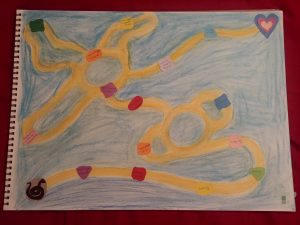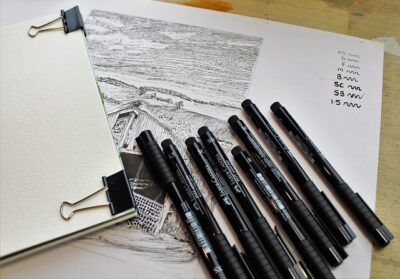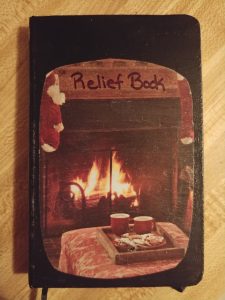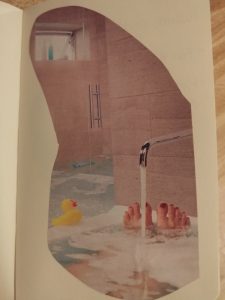 Where do you see yourself in terms of healing by next month? What about in six months or a year? Five years? Ten years? I saw myself still struggling but hopefully managing better. Not long before this exercise, I finally accepted that depression, anxiety, complex PTSD, triggers, intrusive thoughts and an emotional roller coaster were simply my lot in life, one I may have to deal with until the day I die. I stopped fighting its existence and settled on simply managing. This exercise has been a challenge in terms of realizing and accepting that there truly CAN BE a point of healing. After all the counsel I had received with little progress in nine years, five years of rotating therapists thanks to a government system, my current and absolutely amazing therapist thinking I was mentally healthy- until it all became visible with the next drama-filled, controlling church situation, that is!- and all of the messages on “whatsoever state I am, therewith to be content” (KJV, Philippians 4:11), I gave up hope of having my life back. But this exercise gave me a light at the end of the tunnel, a path laden with stepping stones to get there. I could visibly see the areas I needed to develop in to get to where I wanted to be mentally, emotionally, and hopefully, spiritually.
Where do you see yourself in terms of healing by next month? What about in six months or a year? Five years? Ten years? I saw myself still struggling but hopefully managing better. Not long before this exercise, I finally accepted that depression, anxiety, complex PTSD, triggers, intrusive thoughts and an emotional roller coaster were simply my lot in life, one I may have to deal with until the day I die. I stopped fighting its existence and settled on simply managing. This exercise has been a challenge in terms of realizing and accepting that there truly CAN BE a point of healing. After all the counsel I had received with little progress in nine years, five years of rotating therapists thanks to a government system, my current and absolutely amazing therapist thinking I was mentally healthy- until it all became visible with the next drama-filled, controlling church situation, that is!- and all of the messages on “whatsoever state I am, therewith to be content” (KJV, Philippians 4:11), I gave up hope of having my life back. But this exercise gave me a light at the end of the tunnel, a path laden with stepping stones to get there. I could visibly see the areas I needed to develop in to get to where I wanted to be mentally, emotionally, and hopefully, spiritually.
Trauma affects our inner strengths: while some are hindered or seem to disappear, others are strengthened or even created as a result. Certain strengths are particularly helpful with managing stress, especially traumatic stress, and this exercise allows one to create a symbolic path of current strengths and important strengths to develop while moving from the traumatic situation to mental and emotional wellness. With a provided list of inner strengths in hand for ideas and support, I was to choose between five and ten strengths that I currently possess and then describe on paper how they have been affected by my traumatic experiences as well as ones that formed because of them. Later in the exercise, I was to take colored stones and coordinate each one with the inner strengths that I already possess:
-
-
- Strong-will: I am more compassionate towards others, but even-more ready to fight for others and sometimes myself.
Color Choice: Red- Important but can be dangerous
- Encourager: I must spend more time caring for myself and my children now than before and I am often discouraged, but I still try to encourage others when I can.
Color Choice: Blue- Calm, ethos
- Organizational Skills (new): This has greatly developed as a result of attempting to manage anxiety through obsessive compulsive tendencies.
Color Choice: Orange- more OCD-based, requires a lot of energy and attention
- Sensitivity to others: I have always been sensitive to noticing the emotional and circumstantial struggles of others, but I am even more aware. I am now, however, more guarded of my own emotions and struggles.
Color Choice: Darker Purple- ethos, feelings
- Curiosity: I am now much more careful.
Color Choice: Yellow- inquisitive
- Honesty: This one has been greatly strengthened. I hate being lied to or deceived.
Color Choice: Green- pure
- Integrity: When I completed this, I wrote “questionable,” but truly, I have a strong desire to do right, just not under the confines of legalism. I need to figure out what is right in freedom versus what is actually sin.
Color Choice: Pink- raw
- Optimism/Innocence (on initial list of affected strengths but not on picture): Basically gone.
Now that I can visibly see a list of my strengths, rather than just the areas I felt like I had failed, the authors provide a list of inner strengths that are key to progressing towards wellness. I was to create several “stepping stones” and chose colors to correspond with the inner strengths already listed directly in the exercise (Managing Traumatic Stress Through Art, Page 28):
-
-
- “Determination to overcome the trauma (Red)
- Will to struggle and succeed (Orange)
- Faith in myself and supportive others (Yellow)
- Courage to explore circumstances and aftereffects of my trauma (Green)
- Responsibility to meet my personal needs (Pink for vulnerability)
- Creativity to imagine inner balance (Light purple)
- Resilience to inner stress (Light blue- requires calmness)
- Open-mindedness for growth (Yellow- requires optimism)”
While I certainly did not have faith in myself and supportive others, resilience for inner stress, or even the creativity to imagine inner balance, there were several I could see that I already possessed: determination to overcome the trauma, open-mindedness for growth, and working on being responsible to meet my personal needs. Others were just starting to grow: courage to explore the circumstances and aftereffects, and a will to struggle and succeed. I was nowhere near ready for some, but I was surprised to realize that I was already cultivating several of these strengths even though others seemed impossible to obtain.
Finally, I was to design a path that was symbolic of my own recovery process. For me, that path is not straight, but rather winding with twists and curves. It goes to the right, then the left, and back towards the right again. I pictured a traffic circle that looped back to itself, never sure if there would be anything productive or harmful on a given path under already chosen. I chose a snake to represent my trauma, the trauma that started with my mentor’s husband and the hours of mental, emotional and spiritual abuse that went on for years. The hardest part, however, was choosing a symbol to represent “a state of well-being.” Was this even possible? What does it look like? Can I really get from that snake to a place of actually living and enjoying life, a place of spiritual health? I finally settled on a multi-colored heart to represent the various facets of a healthy mental state. I can still only wonder how that time will feel and what it will be like. I am around the middle of my path, unsure of what direction to go in, but I can see those traits I need to develop on the way. I can see the ones that I still have or ones that have resulted because of the trauma. I am not a failure without any character simply because I struggle to read the Bible and pray. But being able to read and pray is definitely one of my future goals for wellness, as is a healthy self-esteem and confidence in how God has made me.
*For more art therapy ideas from Managing Traumatic Stress through Art, check out the full list of exercises from the blog post: “Managing Traumatic Stress Through Art.“
********
Shop at our Amazon store! As an Amazon Influencer, this website earns from qualifying purchases.
 If you could go on vacation anywhere you wanted, where would you go? Would it be the warm, sunny beaches of Hawaii or the Caribbean? The tantalizing, exquisite tastes of Italy or Greece? Maybe more of a rugged adventure in the Outback like the Crocodile Hunter? But then again, how is your work schedule? Do you own your own business or does your boss keep you late? How are your finances? The average person simply does not have the funds and the paid-time off to simply take off work on a whim to take an international excursion or a getaway to some remote area of the country. Some have children and pets to care for, or a house and vehicle to look after. Some cannot get away from their classroom or business for more than a few hours, only to attempt a decent night’s sleep. This exercise is designed to facilitate the opportunity for mental “mini-vacations” through the hum and drum of life when a vacation would not otherwise be possible.
If you could go on vacation anywhere you wanted, where would you go? Would it be the warm, sunny beaches of Hawaii or the Caribbean? The tantalizing, exquisite tastes of Italy or Greece? Maybe more of a rugged adventure in the Outback like the Crocodile Hunter? But then again, how is your work schedule? Do you own your own business or does your boss keep you late? How are your finances? The average person simply does not have the funds and the paid-time off to simply take off work on a whim to take an international excursion or a getaway to some remote area of the country. Some have children and pets to care for, or a house and vehicle to look after. Some cannot get away from their classroom or business for more than a few hours, only to attempt a decent night’s sleep. This exercise is designed to facilitate the opportunity for mental “mini-vacations” through the hum and drum of life when a vacation would not otherwise be possible.

 Where do you see yourself in terms of healing by next month? What about in six months or a year? Five years? Ten years? I saw myself still struggling but hopefully managing better. Not long before this exercise, I finally accepted that depression, anxiety, complex PTSD, triggers, intrusive thoughts and an emotional roller coaster were simply my lot in life, one I may have to deal with until the day I die. I stopped fighting its existence and settled on simply managing. This exercise has been a challenge in terms of realizing and accepting that there truly CAN BE a point of healing. After all the counsel I had received with little progress in nine years, five years of rotating therapists thanks to a government system, my current and absolutely amazing therapist thinking I was mentally healthy- until it all became visible with the next drama-filled, controlling church situation, that is!- and all of the messages on “whatsoever state I am, therewith to be content” (KJV, Philippians 4:11), I gave up hope of having my life back. But this exercise gave me a light at the end of the tunnel, a path laden with stepping stones to get there. I could visibly see the areas I needed to develop in to get to where I wanted to be mentally, emotionally, and hopefully, spiritually.
Where do you see yourself in terms of healing by next month? What about in six months or a year? Five years? Ten years? I saw myself still struggling but hopefully managing better. Not long before this exercise, I finally accepted that depression, anxiety, complex PTSD, triggers, intrusive thoughts and an emotional roller coaster were simply my lot in life, one I may have to deal with until the day I die. I stopped fighting its existence and settled on simply managing. This exercise has been a challenge in terms of realizing and accepting that there truly CAN BE a point of healing. After all the counsel I had received with little progress in nine years, five years of rotating therapists thanks to a government system, my current and absolutely amazing therapist thinking I was mentally healthy- until it all became visible with the next drama-filled, controlling church situation, that is!- and all of the messages on “whatsoever state I am, therewith to be content” (KJV, Philippians 4:11), I gave up hope of having my life back. But this exercise gave me a light at the end of the tunnel, a path laden with stepping stones to get there. I could visibly see the areas I needed to develop in to get to where I wanted to be mentally, emotionally, and hopefully, spiritually. This is one that I LOVE already: The Comfort Box! The idea is to take any box with a lid (shoe box, file box, oatmeal box, etc.) and fill it with items that are comforting, set aside for times of stress, depression, anxiety, fears, and overwhelming emotions. One of the best parts is that the box can be as plain or as decorated as desired, not requiring any level of craftiness or artistic ability, but decorating it can be just as therapeutic as the items inside. For mine, I chose a simple file box from Walmart and covered it in soft, snuggle-fabric that was seventy-percent off on President’s Day.
This is one that I LOVE already: The Comfort Box! The idea is to take any box with a lid (shoe box, file box, oatmeal box, etc.) and fill it with items that are comforting, set aside for times of stress, depression, anxiety, fears, and overwhelming emotions. One of the best parts is that the box can be as plain or as decorated as desired, not requiring any level of craftiness or artistic ability, but decorating it can be just as therapeutic as the items inside. For mine, I chose a simple file box from Walmart and covered it in soft, snuggle-fabric that was seventy-percent off on President’s Day.
 Who do you reach out to when the blessings come or when life takes a turn for the worse? Who do you celebrate with when you get a promotion, a new house, new car, or a baby on the way, furry or otherwise? Who mourns with you and gives guidance when you are laid off from work, the house catches fire, the vehicle is totaled, or a family member is at death’s door? Too bad we cannot really call the
Who do you reach out to when the blessings come or when life takes a turn for the worse? Who do you celebrate with when you get a promotion, a new house, new car, or a baby on the way, furry or otherwise? Who mourns with you and gives guidance when you are laid off from work, the house catches fire, the vehicle is totaled, or a family member is at death’s door? Too bad we cannot really call the  Does the trauma ever cause you to shut-down to the point of indifference and apathy, merely attempting to survive through the day only to repeat the next day? Are there hobbies or activities that you enjoy, things that pique your interest and curiosity, or is there no time, no energy, and no desire to even try? Yep, that’s me. Many times over and more days than I can count like that over the last decade. Because of trauma, people sometimes close themselves off for the sake of survival, in turn creating a situation where they do not experience the many sensory aspects of life.
Does the trauma ever cause you to shut-down to the point of indifference and apathy, merely attempting to survive through the day only to repeat the next day? Are there hobbies or activities that you enjoy, things that pique your interest and curiosity, or is there no time, no energy, and no desire to even try? Yep, that’s me. Many times over and more days than I can count like that over the last decade. Because of trauma, people sometimes close themselves off for the sake of survival, in turn creating a situation where they do not experience the many sensory aspects of life. hip cookies with a crispy outsides and soft, tender insides, and rib eye steaks seared and seasoned to perfection with savory sides. I found pictures of furry kittens with massive eyes and little twitching ears, and long-haired dogs to imagine snuggling with and running through their long coats, smelling that all-too familiar dog smell and of course that not-so-pleasant dog-breath, something that somehow brought comfort in the known.
hip cookies with a crispy outsides and soft, tender insides, and rib eye steaks seared and seasoned to perfection with savory sides. I found pictures of furry kittens with massive eyes and little twitching ears, and long-haired dogs to imagine snuggling with and running through their long coats, smelling that all-too familiar dog smell and of course that not-so-pleasant dog-breath, something that somehow brought comfort in the known. ed, and reacquaint oneself with feeling, seeing, hearing, touch and taste. It reawakens the senses that have not had a variety of stimulation recently due to the depression or anxiety. One of my favorites in this book ended up being in a nice, warm bath. I could feel the warm water around me, touch and see the bubbles floating. I could hear birds chirping outside the small window, singing in my own little haven. I could smell the body wash as it gingerly filled the air, reminiscent of the flowers blooming outside. I had no idea how to get back in touch with the things I was missing and longing for until I was able to create a book, just for me, that had a plethora of the things that I enjoyed.
ed, and reacquaint oneself with feeling, seeing, hearing, touch and taste. It reawakens the senses that have not had a variety of stimulation recently due to the depression or anxiety. One of my favorites in this book ended up being in a nice, warm bath. I could feel the warm water around me, touch and see the bubbles floating. I could hear birds chirping outside the small window, singing in my own little haven. I could smell the body wash as it gingerly filled the air, reminiscent of the flowers blooming outside. I had no idea how to get back in touch with the things I was missing and longing for until I was able to create a book, just for me, that had a plethora of the things that I enjoyed.